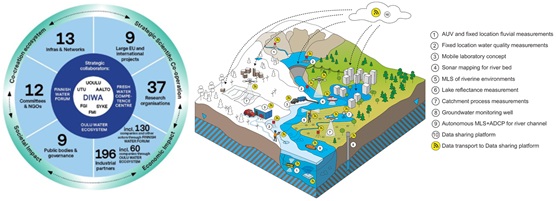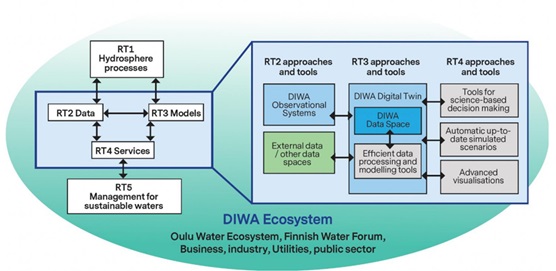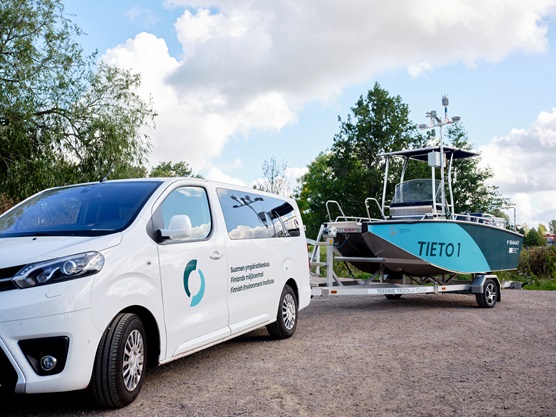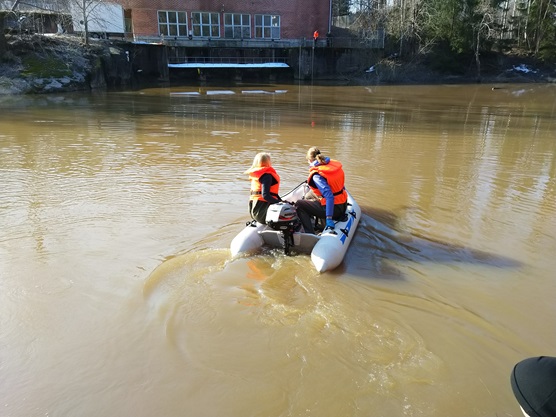
Figure 1. The DIWA co-operation, societal and economic impact (left) with the HYDRO-RI Platform infra with autonomous and remotely controlled survey and measuring platforms for studying hydrological processes, water quality, fluvial processes, river habitats and freshwater management, and renewing science related to sustainable water management.
Background
The Digital Waters Flagship (DIWA) aims to become a top-tier water research cluster and innovation ecosystem that generates high-impact research outputs, input to policy development and innovations facilitating the next industrial water revolution. DIWA enables a transition towards the digital representation of real-world water systems (digital twins) to reproduce hydrological storages and their usage, with novel options for improved scenario analysis, planning and governance. The project is supported by doctoral education pilots, where over 80 doctors are educated.
DIWA enables a transition towards the digital representation of real-world water systems (digital twins) to reproduce hydrological storages and their usage, with novel options for improved scenario analysis, planning and governance. The digitalisation of water resources will improve the management and security of water supply, distribution and use, for example in the event of flooding or droughts. Digital water management will also help balance the objectives of industry, energy, agriculture and forestry in a sustainable way.
The solutions provided by the DIWA Flagship are urgently needed as water is a critical natural resource globally. Climate change, biodiversity loss, environmental pollution and water scarcity require additional investments that will increase the value of water. The water sector has business potential worth several billion euros and is expected to grow rapidly.
Cooperation is based nationally many networks such as the Freshwater Competence Centre partnership, Finnish Water Forum and Water Clusters in Finland like the Oulu “OIA” Water Ecosystem as well as many international networks like The Water4All Partnership. The partners work closely with public and private stakeholders.
The Syke is a key player in DIWA led by the University of Oulu (Professor: Björn Klöve), and it is part of the Flagship Programme of the Academy of Finland. The DIWA supports high-level research and the extensive economic and societal effectiveness that is derived from it.
Objectives
The DIWA Flagship will implement the goals of the Finnish international water strategy in practice. DIWA will integrate the critical knowledge and skills for advancing the Digital Earth concept that is evolving rapidly to play a strategic role in the Anthropocene epoch. DIWA researchers have already established Freshwater Competence Centre FWCC in 2020 that will provide DIWA with the essential infrastructures to develop digital solutions. DIWA is active in the 2 EU Destination Earth Initiative (DestinE 2023) and Water4all programme and its Strategic Research and Innovation Agenda (SRIA 2023).
The DIWA established a Digital Twin that is an appropriate high-performance observation and computing infrastructure that hosts big data, models and user interface and provides services connecting input data at various scales, models and output to provide an improved “digital ecosystem”. The Digital twin is being developed under DIWAs’ research themes:
RT1: Hydrosphere processes RT2: New observational systems RT3: Integrated analysis and modelling RT4: Digital services, platforms, and business applications RT5: Transformative water management
Mission
Our mission is to FORM, FACILITATE and FOSTER a new generation of the water sector (academia-business-public sector). We enable a transition towards the digital representation of real-world water systems (Digital Twin) to reproduce hydrological storages, their states, fluxes and processes, as well as ecosystem responses with novel options for improved scenario analysis, planning and governance.
Research plan
Implementation of the plan: The Flagship is structured around five main interdisciplinary and interconnected Research Themes (RTs) that are studied in the concept of digital twin as outlined in Fig. 2 to foster business innovations and solve key societal challenges (e.g. Fig.1).

Figure 2. DIWA ecosystem and its methodological frame, where RT1 provides the scientific basis for the natural system as a basis for the digital twin development RT2-RT3 (the process is outlined in the right panel). RT5 codevelops and integrates the scientific basis for the needs of the societal boundaries and water sector businesses.

Figure 3. DIWA infrastructure helps to measure spatially climate gases and water quality in various sites, in the figure TIETO I boat as part of our infrastructure in the Freshwater Competence Center.
Projects
Project: Digital waters flagship (DIWA) Home - digitalwaters.fi
Project: PhD. pilots PhD Pilot - digitalwaters.fi (DIWA linked project 60-85 PhD.)
Partnership: The Water4All Partnership
Partnership: The Freshwater Competence Centre in Finland
Network: Hydro-RDI-Network Hydro-RDI-Network projects
Network: Finnish Water Forum
Infra – EU: AquaINFRA will develop data and services to support marine and freshwater scientists and stakeholders
Infra - Finnish: Hydrological research infrastructure (HYDRO-RI-Platform)
Service: When ice breaks – Freshwater Competence Centre
Service: Data fusion, is a Integrated and scalable water quality data and services (Pro Quality Data)
Research: Green and digital transition in river basin management (Green-Digi-Basin)

Figure 4. The DIWA is supported by the FWCC supersites one of which in the River Vantaanjoki © Jari Silander
Literature
Alho, P.; Vaaja, M.; Kukko, A.; Kasvi, E.; Kurkela, M.; Hyyppa, J.; Hyyppa, H.; Kaartinen, H.A. (2011) Mobile laser scanning in fluvial geomorphology: Mapping and change detection of point bars. Z. für Geomorphol, 55, 31–50.
Kahiluoto, J., Hirvonen, J. & Näykki, T.(2019). Automatic real-time uncertainty estimation for online measurements: a case study on water turbidity. Environ Monit Assess 191, 259. https://doi.org/10.1007/s10661-019-7374-7.
Kløve, B. Ala-Aho, P. Bertrand, G. Gurdak, J. J. Kupfersberger, H. Kvœrner, J. Muotka, T. Mykrä, H. Preda, E. Rossi, P. Bertacchi Uvo, C. Velasco, E. Wachniew, P. Pulido-Velázquez, M. 2014. Climate Change Impacts on Groundwater and Dependent Ecosystems. Journal of Hydrology 518: 250– 266.
Lotsari, E., Lintunen, K., Kasvi, E., Alho, P., & Blåfield, L. 2022. The impacts of near-bed flow characteristics on river bed sediment transport under ice-covered conditions in 2016–2021. Journal of Hydrology, 615, 128610.
Lotsari, E.; Vaaja, M.; Flener, C.; Kaartinen, H.; Kukko, A.; Kasvi, E.; Hyyppä, H.; Hyyppä, J.; Alho, P. (2014) Annual bank and point bar morphodynamics of a meandering river determined by high-accuracy multitemporal laser scanning and flow data. Water Resour. Res., 50, 5532–5559.
Marttila H, Laudon H, Tallaksen LM, Jaramillo F, Alfredsen K, Ronkanen A-K, Kronvang B, Lotsari E, Kämäri M, Ala-Aho P, Nousu J, Silander J, Koivusalo H, Kløve B. 2022. The Nordic Hydrological Frontier in the 21st Century. Hydrology Research, 53(5), 700–715. https://doi.org/10.2166/nh.2022.120.
Marttunen & Hämäläinen (2008). The Decision Analysis Interview Approach in the Collaborative Management of a Large Regulated Water Course, Environmental Management 42: 1026–1042.
Rigon, R., Formetta, G., Bancheri, M., Tubini, N., D'Amato, C., David, O., and Massari, C. 2022: HESS Opinions: Participatory Digital eARth Twin Hydrology systems (DARTHs) for everyone – a blueprint for hydrologists, Hydrol. Earth Syst. Sci., 26, 4773–4800.
SRIA (2023)
Veijalainen, N., Lotsari, E., Alho, P., Vehviläinen, B., & Käyhkö, J. 2010. National scale assessment of climate change impacts on flooding in Finland. Journal of hydrology, 391(3-4), 333-350.
Additional information
- Professor Uvo Cintia, p. +358 295 251 555, firstname.lastname@syke.fi
- Senior research scientist Jari Silander, p. +358 295 251 638, firstname.lastname@syke.fi